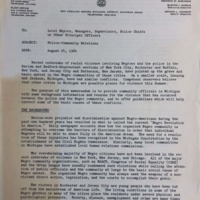4. Radicalization and Civil Protest
Rough Outline
Cavanagh’s’ liberal reforms of the police department were ineffective and the expansion of police power enabled prejudiced officers to over-police low-income, majority-black neighborhoods. This, combined with gaps in access to social services and inequalities between black middle-class and working-class Detroiters, led to the rise of radical black organizations that embraced Black Power as a means for social change.
- Conditions that led to the rise of radical black organizations:
- gaps in access to social services
- the realization that civil rights organizations like the DUL and NAACP work for middle-class black residents and neglect working-class poor black residents
- Black Power:
- What is it?
- National origins
- Detroit manifestations
- Preview of section: Growth and work of ACME, conflicts with the police that manifest in the Kercheval Incident, Kercheval aftermath (praise of DPD, black radical groups’ resentment of the DPD, city’s plans to prevent riots through new recreation programs and social services)
How to Prevent a Riot
In August 1964, the Michigan Civil Rights Commission (MCRC) sent this memo to city leaders across the state, offering a set of guidelines to prevent racial riots. The report informs them that “young people who have been cut off from the mainstream of American life” typically started these disturbances because they had lost “hope or faith in the American dream” and felt “that they [had] nothing to lose.” Because African American citizens faced inequality in nearly every realm of American life, many had serious grievances against the power structure. Urban uprisings frequently began with confrontations between police officers and young African American men because “frequent contact with the policeman on the beat often makes the policeman the most convenient symbol of total oppression.”
While acknowledging that the “total oppression” of African American citizens truly caused this unrest and could not be changed overnight, the MCRC offered to Michigan cities guidelines for taking “preventative action.” For years, civil rights organizations in cities such as Detroit had made exactly the same recommendations, advising police departments to train officers in human relations, actively recruit from minority groups, and establish procedures for reviewing police brutality complaints. As the Cavanagh administration would find in the mid-1960s when it tried to implement these reforms, changes in department policies frequently failed to change the way officers behaved on the streets.

